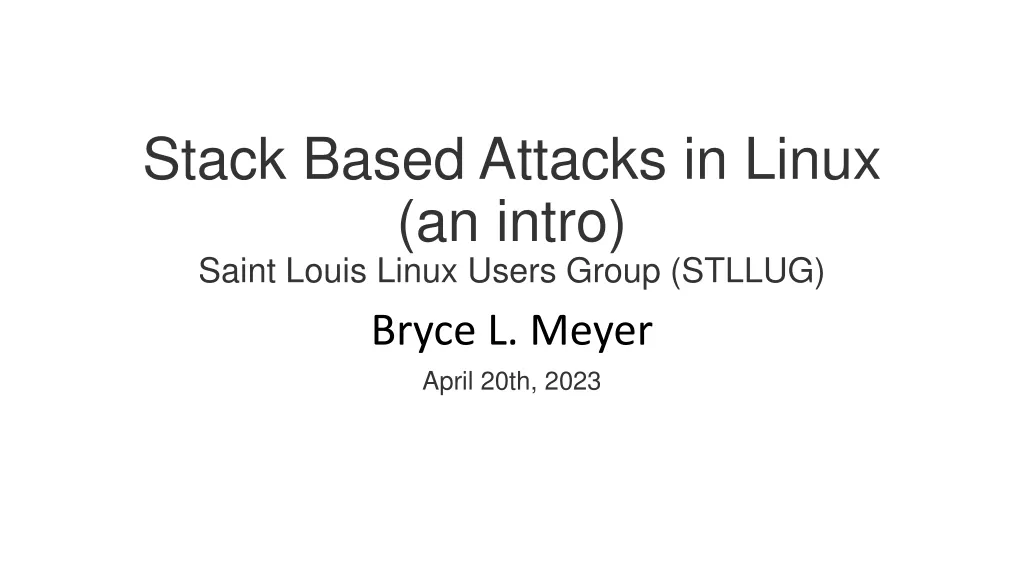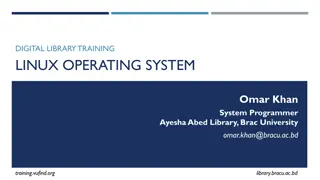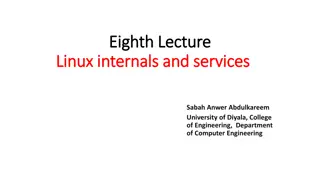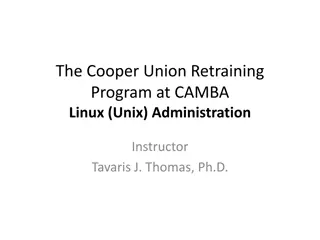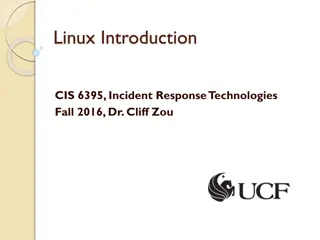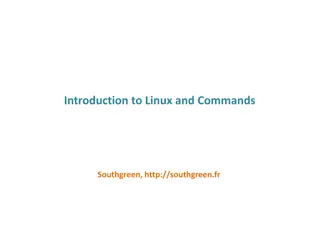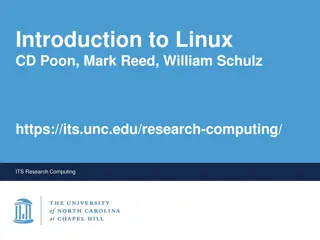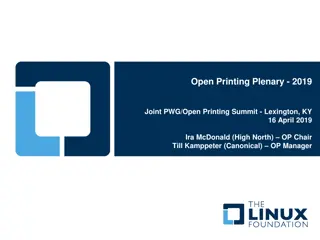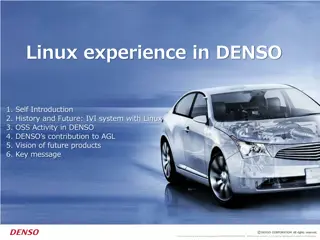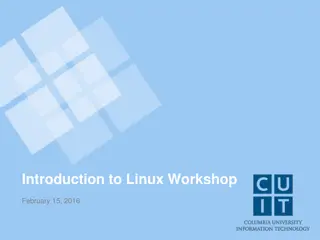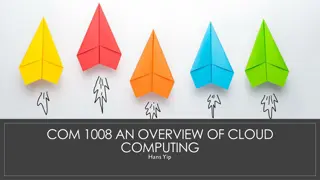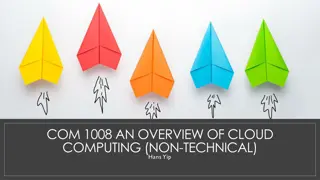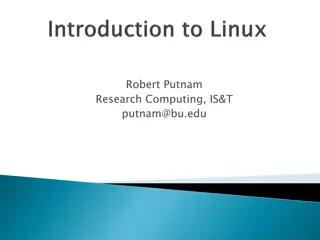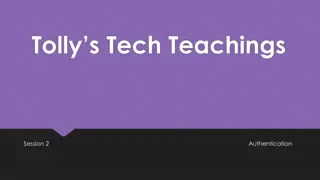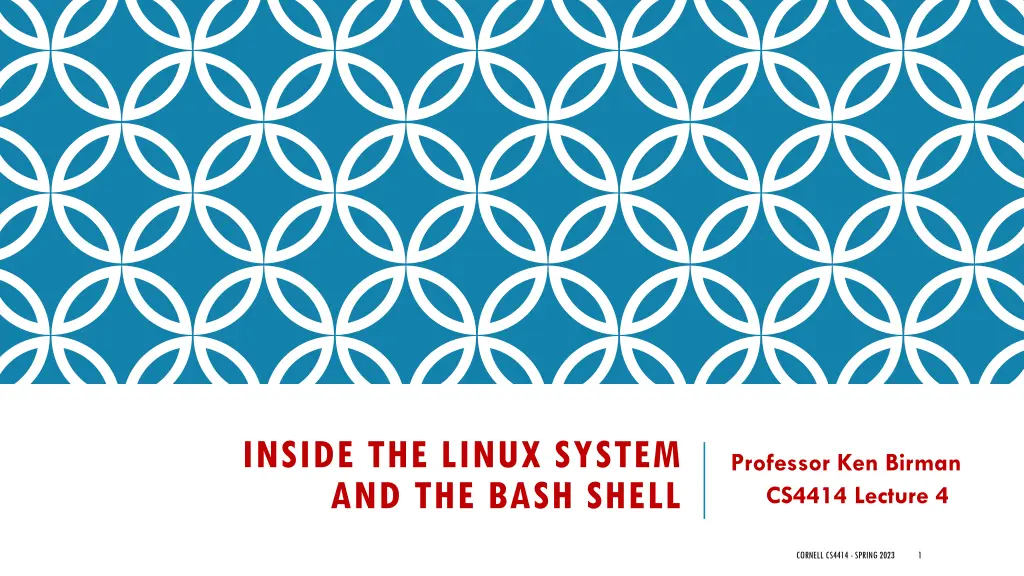
Exploring Linux System and Bash Shell for Enhanced Performance
Dive into the inner workings of the Linux system and Bash shell with Professor Ken Birman in CS4414 lecture series at Cornell University. Learn about Linux commands, process abstraction, daemons, and more to optimize program performance. Discover the significance of daemon programs running in the background and their role in system efficiency and operation.
Download Presentation

Please find below an Image/Link to download the presentation.
The content on the website is provided AS IS for your information and personal use only. It may not be sold, licensed, or shared on other websites without obtaining consent from the author. If you encounter any issues during the download, it is possible that the publisher has removed the file from their server.
You are allowed to download the files provided on this website for personal or commercial use, subject to the condition that they are used lawfully. All files are the property of their respective owners.
The content on the website is provided AS IS for your information and personal use only. It may not be sold, licensed, or shared on other websites without obtaining consent from the author.
E N D
Presentation Transcript
INSIDE THE LINUX SYSTEM AND THE BASH SHELL Professor Ken Birman CS4414 Lecture 4 CORNELL CS4414 - SPRING 2023 1
IDEA MAP FOR TODAY If our program will run on Linux, we should learn about Linux How programs learn what to do: rc files, environment variables, arguments Process abstraction. Daemons Along the way many useful Linux commands and bash features CORNELL CS4414 - SPRING 2023 2
RECAP We saw that when our word-count program was running, parallelism offered a way to get much better performance from the machine, as much as a 30x speedup for this task. In fact, Linux systems often have a lot of things running on them, in the background (meaning, not talking to the person typing commands on the console. ) CORNELL CS4414 - SPRING 2023 3
STUFF THAT WAS RUNNING ON A SERVER At a random moment on a server similar to the setup in the CS engineering server pool, what happens to be running? Ken made these next two slides to show you CORNELL CS4414 - SPRING 2023 4
WHATS WITH THE ????? STUFF? apparently those are escaped newline characters! In fact any non-printing characters are shown as ? CORNELL CS4414 - SPRING 2023 9
LETS SUMMARIZE SOME OF WHAT WE SAW In addition to the Linux operating system kernel , Linux had many helper programs running in the background. We used the term daemon programs for these. The term is a reference to physics, but a bit obscure. A daemon program is launched during startup (or periodically) and doesn t connect to a console. It lives in the background. CORNELL CS4414 - SPRING 2023 10
YOU CAN ALSO CREATE BACKGROUND TASKS OF YOUR OWN One way to do this is with a command called nohup , which means when I log out ( hang up ), leave this running. A second is with a command named disown . When you log out, bash kills any background jobs that you still own. If you disown a job, it leaves it running CORNELL CS4414 - SPRING 2023 11
ONE REASON FOR DAEMONS: PERIODIC TASKS In production systems, many things need to happen periodically Linux and C++ have all sorts of features to help Within Linux, a tool called cron (for chronological ) runs jobs on a schedule that you can modify or extend Example: Once every hour, check for new photos on the camera and download them. CORNELL CS4414 - SPRING 2023 12
HOW CRON WORKS There is a file in a standard location called the crontab , meaning table of jobs that run chronologically Each line in the file uses a special notation to designate when the job should run and what program to launch The program itself could be in any language and can even be a Linux bash script (also called a shell script ). CORNELL CS4414 - SPRING 2023 13
HOW AT WORKS Very similar to cron, but for a one-time command The atd waits until the specified time, then runs it Whereas cron is controlled from the crontab file, at is used at the command-line. CORNELL CS4414 - SPRING 2023 14
HOW DO THESE PROGRAMS KNOW WHAT WE WANT THEM TO DO? On Linux, programs have three ways to discover runtime parameters that tell them what to do. Arguments provided when you run the program, on the command line Configuration files, specific to the program, that it can read to learn parameter settings, files to scan, etc. Linux environment variables. These are managed by bash and can be read by the program using getenv system calls. CORNELL CS4414 - SPRING 2023 15
PROGRAMS CONTROLLED BY CONFIGURATION FILES In Linux, many programs use some sort of configuration file, just like cron is doing. Some of those files are hidden but you can see them if you know to ask. In any directory, hidden files will simply be files that start with a name like .bashrc . The dot at the start says invisible If you use ls a to list a directory, it will show these files. You can also use echo .* to do this, or find, or .... CORNELL CS4414 - SPRING 2023 16
A FEW COMMON HIDDEN FILES Bash replaces ~ with the pathname to your home directory ~/.bashrc The Bourne shell (bash) initialization script ~/.vimrc A file used to initialize the vim visual editor ~/.emacs A file used to initialize the emacs visual editor /etc/init.d When Linux starts up, the files here tell it how to configure the entire computer /etc/init.d/cron Used by cron to track periodic jobs CORNELL CS4414 - SPRING 2023 17
VISUAL STUDIO CODE USES THEM TOO When you create or open a project, it makes a folder called .vscode. You can see it if you look for it Settings are in files with a .json extension JSON is the Javascript Object Notation, and is a way to write down (in a file) information about an object or data structure CORNELL CS4414 - SPRING 2023 18
launch.json "version": "0.2.0", "configurations": [ "tasks": [ { "type": "cppbuild", "label": "C/C++: gcc build active file", "command": "/usr/bin/gcc", "args": [ -std=C++20 , "-fdiagnostics-color=always", "-g", "${file}", "-o", "${fileDirname}/${fileBasenameNoExtension}" ], "options": { "cwd": "${fileDirname}" }, "problemMatcher": [ "$gcc" "ignoreFailures": true }, { "description": "Set Disassembly Flavor to Intel", "text": "-gdb-set disassembly-flavor intel", "ignoreFailures": true } ] } ] } tasks.json { "name": "(gdb) Launch", "type": "cppdbg", "request": "launch", "program": "${workspaceFolder}/scheduler.c", "args": [], "stopAtEntry": false, "cwd": "${workspaceRoot}", "environment": [], "externalConsole": false, "MIMode": "gdb", "miDebuggerPath": "/usr/bin/gdb", "setupCommands": [ { "description": "Enable pretty-printing for gdb", "text": "-enable-pretty-printing", VISUAL STUDIO USES THEM TOO The items are intended to have obvious meanings Sometimes we need to edit these, but more often we use pulldown menus on configuration edit pages that really just load the JSON file, format it nicely, and then write it back ], "group": { "kind": "build", "isDefault": true }, "detail": "Task generated by Debugger." } ], "version": "2.0.0" } When working remotely there will be a separate one for the remote machine, perhaps different from your local one! CORNELL CS4414 - SPRING 2023 19
ENVIRONMENT VARIABLES The bash configuration file is used to set the environment variables. Examples of environment variables on Ubuntu include HOME: my home directory USER: my login user-name PATH: A list of places Ubuntu searches for programs when I run a command PYTHONPATH: Where my version of Python was built CORNELL CS4414 - SPRING 2023 20
ENVIRONMENT VARIABLES The bash configuration file is used to set the environment variables. Other versions of Linux, like CentOS, RTOS, etc might have different environment variables, or additional ones. And different shells could use different variables too! Examples of environment variables on Ubuntu include HOME: my home directory USER: my login user-name PATH: A list of places Ubuntu searches for programs when I run a command PYTHONPATH: Where my version of Python was built CORNELL CS4414 - SPRING 2023 21
EXAMPLE, FROM KENS LOGIN HOSTTYPE=x86_64 USER=ken HOME=/home/ken SHELL=/bin/bash PYTHONPATH=/home/ken/z3/build/python/ PATH=/home/ken/.local/bin:/usr/local/sbin:/usr/local/bin:/usr /sbin:/usr/bin:/sbin:/bin:/usr/games:/usr/local/games CORNELL CS4414 - SPRING 2023 22
SO LETS WALK THROUGH THE SEQUENCE THAT CAUSES THESE TO BE USED We will review 1) How Linux boots when you restart the computer 2) How bash got launched (this is when it read .bashrc) 3) How a command like c++ gets launched CORNELL CS4414 - SPRING 2023 23
WHEN UBUNTU BOOTS Ubuntu is a version of Linux. It runs as the operating system or kernel . But when you start the computer, it isn t yet running. Every computer has a special firmware program to launch a special stand-alone program call the bootstrap program. In fact this is a 2-stage process (hence stage bootloader ) This stand-alone program than reads the operating system binary from a file on disk into memory and launches it. CORNELL CS4414 - SPRING 2023 24
WHAT ABOUT UBUNTU ON WINDOWS? Microsoft Windows has a microkernel on which they can host Ubuntu as a kind of application. (Same with MacOS, via bootcamp) In effect, both Windows and Ubuntu are apps that in turn can host and run additional programs, all on your machine. Early virtualization approaches of this kind were slow, but over time they have become highly performant. Now we do this all the time. CORNELL CS4414 - SPRING 2023 25
UBUNTU LINUX STARTS BY SCANNING THE HARDWARE Linux figures out how much memory the machine has, what kind of CPU it has, what devices are attached, etc. It accesses the same disk it booted on to learn configuration parameters and also which devices to activate. For these activated devices, it loads a device driver . Then it starts the init daemon. CORNELL CS4414 - SPRING 2023 26
THE INIT AND RLOGIN DAEMONS The init daemon is the parent of all other processes that run on an Ubuntu Linux system. /etc/init.d told it what to initially do at boot time. It launched cron and the at daemon, and it also launches the application that allows you to log in and have a bash shell connected to your console. The rlogin daemon allows remote logins, if you configured Ubuntu to permit them. If firewalls and IP addresses allow, you can then use rlogin to remotely connect to a machine, like I did to access compute30 on Fractus. CORNELL CS4414 - SPRING 2023 27
WHEN YOU LOG IN The login process sees that ken is logging in. It checks the secure table of permitted users and makes sure I am a user listed for this machine if not, goodbye ! In fact I am, and I prefer the bash shell. So it launches the bash shell, and configures it to take command-line input from my console. Now when I type commands, bash sees the string as input. CORNELL CS4414 - SPRING 2023 28
BASH INITIALIZES ITSELF The .bashrc file is executed by bash to configure itself for me I can customize this (and many people do!), to set environment variables, run programs, etc it is actually a script of bash commands, just like the ones I can type on the command line. By the time my command prompt appears, bash is configured. CORNELL CS4414 - SPRING 2023 29
WHEN WE LAUNCH PROGRAMS Bash (or cron, or whatever) looks for the program to launch using the PATH variable as guidance on where to look. A special Linux operation called fork followed by exec runs it. The program is now active and will read the environment plus any arguments you provided to know what to do. Some programs fail at this stage because they can t find a needed file in the places listed in the relevant path, or an argument is wrong. CORNELL CS4414 - SPRING 2023 30
EXAMPLE It s a UNIX System! I know this. I log in, and then edit a file using vim (Sagar prefers emacs). So: 1. init ran a login daemon. 2. That daemon launched bash. 3. Bash initialized using .bashrc, then gave a command-line prompt 4. When I ran vim , bash found the program and ran it, using PATH to know where to look. which vim would tell me which it found. 5. Vim initialized itself, and created a visual editing window for me. CORNELL CS4414 - SPRING 2023 31
BASH NOTATION First, just to explain about prompts , bash has a command prompt that it shows when it is waiting for a command: ken@compute30: echo Hello world Even if my slide doesn t show a prompt, it is really there. You can customize it to show anything you like (your computer name, the folder you are in, etc). On old Linux systems, it was % CORNELL CS4414 - SPRING 2023 32
BASH NOTATION First, just to explain about prompts , bash has a command prompt that it shows when it is waiting for a command: ken@compute30:echo Hello world Even if my slide doesn t show a prompt, it is really there. You can customize it to show anything you like (your computer name, the folder you are in, etc). On old Linux systems, it was % CORNELL CS4414 - SPRING 2023 33
BASH NOTATION In a bash script, you can always set environment variables using the special bash command export (or the older setenv ): export PATH=/bin Normally you want to add a directory to path. To do this you expand the old value: export PATH=$PATH:$HOME/myapp/bin This says that in my home directory is a directory myapp/bin with programs I might want to run. Bash will now look there, too. CORNELL CS4414 - SPRING 2023 34
BASH NOTATION In fact bash allows a shorthand version too % PATH=$PATH:$HOME/myapp/bin or even % PATH=$PATH:~/myapp/bin # ~ is short for $HOME Why so many notations? Linux evolved over 40 years people got tired of typing export or setenv or $HOME CORNELL CS4414 - SPRING 2023 35
DIRECTORIES, FILES Linux organizes files into a tree. Even a directory is actually a special kind of file. Use ls l to see details about a file. Chdir ( cd ) to enter a directory. / is the root of the file system tree. . refers to the current directory. .. is a way to access the parent directory. In the bash shell, ~ refers to your home directory. http://researchhubs.com/post/computing/linux-cmd/linux-directory.html CORNELL CS4414 - SPRING 2023 36
RULES ABOUT FILE NAMES Linux directories limit the length of a file name to 255 chars. The maximum length of a pathname, from the root, is 4096 Alphanumeric and a few characters like . _ - Unlike Windows and Mac, don t use spaces in file names. CORNELL CS4414 - SPRING 2023 37
PROCESSES When you launch a process (lke from bash), it gets executed and has a process id. The ps and top commands let you see what you have running You can kill a process in various ways: ^C, kill pid, logging out (there is also a way to prevent this, called nohup ) CORNELL CS4414 - SPRING 2023 38
LINUX COMMANDS There are hundreds of them! In fact you have to install them, in batches, because they use so much space if you install everything. Learn about each command using its manual page. Just google it, like Linux find command (or man 1 find ) CORNELL CS4414 - SPRING 2023 39
ALIASES: A COMMON CAUSE FOR CONFUSION In Linux, one file or program can have multiple names that refer to the identical thing! and some programs even check to see which name you typed when launching them, and customize their behavior accordingly For example, c++ is really an alias for gcc or clang CORNELL CS4414 - SPRING 2023 40
COMMANDS ARE REALLY EXECUTABLE FILES: READ/WRITE/EXECUTE FILE PERMISSIONS Each file in Linux has permissions, visible via ls l . Permissions are shown as [dlcb]rwxrwxrwx. The d, if present, means that this file is a directory. The other letters are for special types of files The next three are permissions for the user who created the file The next three are for other users in the owner s group The last three are for users outside these two categories CORNELL CS4414 - SPRING 2023 41
INODE NUMBERS We will look more closely at this Linux concept in a different lecture An entry in a directory is actually a tuple: The file name Its inode number init.d 34 Each hard drive has a table of inodes. Each is a data structure holding all the information about the file with the corresponding inode number. CORNELL CS4414 - SPRING 2023 42
SPECIAL FILES (S/D/C/B/R) Linux uses file names to refer to devices like the disk, or your camera (if you attach it) or your computer display and keyboard. There are also files types with other special meanings: Links: a way to give a file a second name (an alias ) c or b: character (keyboard) or block (disk) devices r: raw . A way to access a device directly . CORNELL CS4414 - SPRING 2023 43
THE PERMISSIONS THEMSELVES Read means allowed to see the contents . For a file, this means the bytes. For a directory, this means you can list the files in the directory. Write means allowed to make changes . For a directory this means creating or deleting files. Execute is very complicated CORNELL CS4414 - SPRING 2023 44
EXECUTE: THEY RAN OUT OF BITS SO THEY GAVE IT MULTIPLE MEANINGS If the file is a program, execute means (attempt to) run the program . This applies even if the filename doesn t end with .exe If the file is a shell file , execute means launch the bash program (or it could be some other shell), and tell it to run it. If the file is a directory, execute means can access files in it . Note: this means you can sometimes read or run a file that you wouldn t be able to see by listing the directory it is in! CORNELL CS4414 - SPRING 2023 45
SUDO Linux has the concept of a superuser . Used when installing programs Running a command using sudo can override the normal restrictions. You ll need this to install extra commands. Be aware that you can also break Linux easily by changing settings or modifying/removing a file that matters. CORNELL CS4414 - SPRING 2023 46
REMEMBER THE DAEMONS? KILLING THEM IS RISKY! Sometimes a computer seems very busy, or even stuck, and novice users will check for what is running and kill it. With sudo you can kill anything! Like a daemon-killing sword but you need to know what you are killing. Linux depends on many of the background daemons! CORNELL CS4414 - SPRING 2023 47
SOME DIRECTORIES TO KNOW ABOUT The current working directory: this is where you are right now, and where files created by commands or programs will be put by default. For example, if you compile fast-wc.cpp and name the executable fwc, you could run it by typing ./fwc If . is in PATH, then you can just type fwc CORNELL CS4414 - SPRING 2023 48
SOME DIRECTORIES TO KNOW ABOUT /tmp is a place for programs to put temporary files needed while executing. These are automatically deleted if you forget to do so (on reboot). /dev/null: a black hole. We ll see a use for it soon! A fun one: You can configure Linux to have a temporary file system entirely in memory ( RAM ). Called /ramfs CORNELL CS4414 - SPRING 2023 49
MOUNT COMMAND Linux treats each storage device (including ramdisk ) as a separate entity. A storage device can be raw meaning blocks of bytes or it can have a file system on it (a tree data structure). At boot time there is just one storage device with an active file system. The mount command attaches a storage device with a file system on it to your directory structure, so that you can access the files in it. CORNELL CS4414 - SPRING 2023 50


